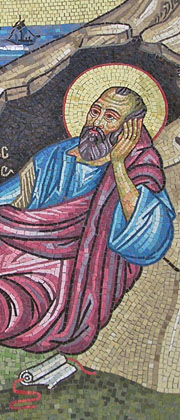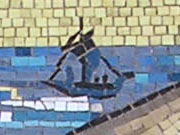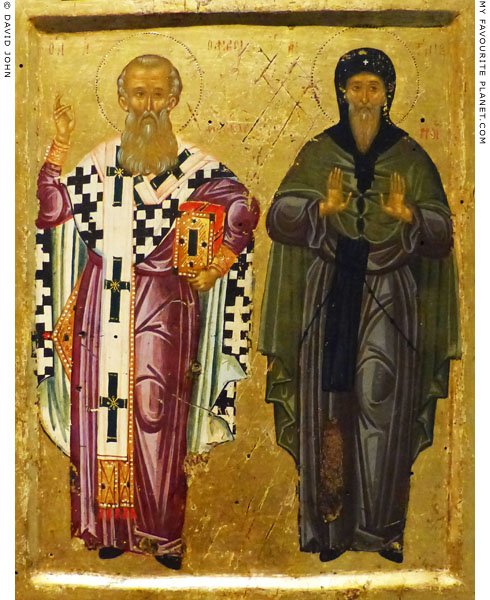|
|
 |
| My Favourite Planet > English > Europe > Greece > Macedonia > Veria |
 |
| Veria, Macedonia, Greece |
History of Veria |
|
 |
page 2 |
 | |
 |

Monument / shrine to Saint Paul the Apostle at the place thought to be Veria's Vima. |
| |
History
of Veria |
Ancient Veria |
 |
| |
Archaeological evidence traces the earliest known human settlement in Veria to 1000 BC, during the early Iron Age. The area was inhabited by Thracian tribes before the arrival of Greek settlers who eventually carved out the kingdom of Macedonia.
 According to myth and legend, the city was named after either its mythical founder Beres (or Pheres), or the daughter of the king of Berroia, said to have been the son of Macedon.
 The first known literary reference to Veria appeared in The History of the Peloponnesian War, written by Thucydides around 432 BC. [1]
 The ancient settlement of Veria became a city along the trade routes of northern Greece, and by late Classical times was the second largest city in Macedonia. Around the end of the 5th century BC, King Archelaos (ruled 413-399 BC) moved his capital from the nearby Aigai (today Vergina, see page 4) to Pella. although Aigai was still inhabitated, retained royal palaces and was used as a place for festivities and burials, Veria must have profited from thus becoming the larger settlement in the area.
 The city flourished into Hellenistic times, and remains have been found from this period of substantial fortification walls, gates and towers, as well as public buildings, an agora and stadium, and sanctuaries of Herakles, Enodias, Athena and Asklepius. |
History
of Veria |
Roman Veria |
 |
 |
|
After the Battle of Pydna in 168 BC, Veria was the first city in Macedonia to be conquered by the Romans. Macedonia became a Roman province, and the new masters contined to fight their wars in this area until Octavian (63 BC - 14 AD) finally defeated his opponents in a number of decisive battles, including Philippi (42 BC) and Actium (31 BC), and took control of the Roman Empire as Emperor Augustus ( see Athens Acropolis page 8).
 In the mid 1st century BC the Romans built the Via Egnatia (Greek, Ἐγνατία Ὁδός), the first highway across the Balkan peninsula, named after Gnaeus Egnatius, proconsul, governor of Macedonia. The road passed just to the south of Veria, continued to Pella, Thessaloniki and ended in Byzantium (today Istanbul). This and other roads built by the Romans in Macedonia must have made travel and trade much easier for its inhabitants and contributed to the prosperity of the area. [2]
 During the Roman period many Jews settled in Veria, establishing a substantial community on the banks of the Tripotamos River at the west of the city during the 1st century BC. [3] The old Jewish quarter, Barbouta, which includes a 19th century synagogue (built or rebuilt in 1850), has recently been restored.
 Under Emperor Diocletian (reigned 284–305 AD) the city became one of the two capitals of the Province of Macedonia, after Thessaloniki, and its wealth and population increased. |
History
of Veria |
Early Christianity |
 |
 |
|
During the first century AD, as the Roman Empire was reaching its zenith of power and territorial extent, a small number of Christian travelling missionaries were gaining converts for the new religion around the Mediterranean.
 Saint Paul the Apostle, himself a Jewish convert to Christianity, made two evangelical tours around the eastern Mediterranean, and brought Christianity to Macedonia during his second tour around 49-51 AD. It was during this visit to the European mainland that he preached in Veria and found a very receptive audience.
 A grand outdoor marble and mosaic monument to his visit has been built on the Víma, the square where he is thought to have preached, at the edge of the modern town ( gallery pages 1-4).
 One of the main mosaics depicts Paul's "Macedonian vision" ( gallery page 2), a scene found in many churches in Macedonia. |
|
| |
History
of Veria |
Saint Paul's Macedonian Vision |
 |
 |
|
According to the Book of Acts in the Bible's New Testament, while in Troas (Troy) in northwestern Asia Minor, during his second evangelical tour, around 49-51 AD, Paul had a vision in which a "a man of Macedonia" asked him to go there to help the people. He interpreted this vision as a call to preach the Gospel in Macedonia.
 Paul was joined on his mission by Silas and Timothy. They set off by ship for Neapolis (modern Kavala), stopping overnight on the North Aegean island of Samothraki before proceeding to Philippi.
Book of Acts chapter 16, verses 8-12
 8. ... and passing by Mysia, they came down to Troas. 8. ... and passing by Mysia, they came down to Troas.

9. A vision appeared to Paul in the night: a man of Macedonia was standing and appealing to him, and saying, "Come over to Macedonia and help us".

10. When he had seen the vision, immediately we sought to go into Macedonia, concluding that God had called us to preach the gospel to them.

11. So putting out to sea from Troas, we ran a straight course to Samothrace, and on the day following to Neapolis

12. and from there to Philippi, which is a leading city of the district of Macedonia, a Roman colony; and we were staying in this city for some days.
Paul eventually went to Thessalonika where he met with opposition to his work from the local jews. So he and Silas moved on to Veria where they received much warmer response. However, their Thessalonian detractors arrived to stir up trouble, forcing Paul to leave for Athens.
Book of Acts chapter 17, verses 10, 11, 13
 10. The brethren immediately sent Paul and Silas away by night to Berea, and when they arrived, they went into the synagogue of the Jews. 10. The brethren immediately sent Paul and Silas away by night to Berea, and when they arrived, they went into the synagogue of the Jews.

11. Now these were more noble-minded than those in Thessalonica, for they received the word with great eagerness, examining the Scriptures daily to see whether these things were so.

13. But when the Jews of Thessalonica found out that the word of God had been proclaimed by Paul in Berea also, they came there as well, agitating and stirring up the crowds. |


Paul's vision |
| |

Paul's ship of dreams |
| |
History
of Veria |
Byzantine Veria |
 |
 |
|
Veria was one of the earliest cities to become the seat of a bishop, according to tradition Saint Onesimus. During the Byzantine period Veria was considered a special place for Christians because of its assocation with Saint Paul, and became known as "Little Jerusalem". As many as 70 churches were built here, of which around 51 Byzantine and post-Byzantine buildings survive today.
 Throughout the Byzantine and Medieval periods the area was invaded several times. Following raids by the Bulgars in the 9th century Veria became part of the First Bulgarian Empire. It was recaptured by Emperor Basil II in 1002 during a brief resurgence of Byzantine power. During the Crusades it was taken by the Normans in 1185 and then by the Franks in 1204. The Serbs occupied the city in the mid 14th century, ousting the Ottoman Turks who had taken the city 1361. |
|
|
 |

Icon of Saint Athanasios of Alexandria and Saint Antonios of Veria
(Άγιος Αντώνιος, also known as Saint Antonios the Younger),
a late 10th century monk who is the patron saint of Veria.

3rd quarter of the 14th century.

Museum of Byzantine Culture, Thessaloniki. Inv. No. BEI 26. |
History
of Veria |
Ottoman Veria |
 |
 |
|
The Ottoman Turks returned to besiege and take the city in 1436, after which it remained part of the Ottoman Empire until the independence of Macedonia in 1912. Under Turkish rule Veria became known as Kara Ferye.
 Although the Ottomans were generally known to be tolerant of religion within their empire, they could be vicious in putting down opposition, rebellion or dissent. There was a repression of the Christian Church in Veria, and in 1436, shortly after the Turks had retaken the city, they hung Archbishop Arsenios from a large plane tree in the town centre which is still shown to visitors. The Christians were forced to worship in secret and their churches were disguised as barns, warehouses and other types of buildings.
 The Ottomans built a number of mosques here, four of which have survived, including the Orta Camii and Medressa Camii. The 15th century Sinan Tuzci Hamam Turkish bath is also a legacy of Ottoman rule. During this period Veria also became an industrial centre producing wool, hemp and flax, for which watermill technology was used.
 In the early 19th century the English historian William Martin Leake visited Veria and wrote the following report:
 "The town contains about 2000 families, of which 1200 are Greek: the houses are lofty, and for Turkey well built. Water flows through every street, supplied either from springs or from the rivulet; which advantage, together with the lofty and salubrious situation, the surrounding gardens, many fine plane-trees interspersed among the houses, the vicinity of the mountains, and a commanding view over the great level to the eastward, renders Verria one of the most agreeable towns in Rumili.
 The manufacturing part of the population spin the hemp and flax grown at the foot of the mountain, and make shirts and towels, particularly the makrama, or large towel used in the public baths, and of which there is a great consumption in all Turkish towns, four of them being required for each bather, besides two more for sheets to the bed on which he reposes after the bath.
 Many of the water-mills around the town are for fulling coarse woollens and carpets, which are made in the surrounding villages or by the Jews of Saloniki." [4]
 Veria was incorporated into the Greek state following the end of the Balkan Wars in 1912. |
|
|
| |
History
of Veria |
Notes, references and links |
 |
|

1. Thucydides on Veria

Thucydides (Greek, Θουκυδίδης, Thoukydides; circa 460-395 BC), Greek historian and author from Alimos (Άλιμος), a coastal district of Athens.

The Athenian historian merely mentions Veria in passing without giving us any further information about the city. However, in writing that the Athenian force "withdrew from Macedonia, going to Beroea..." he indicates that at this time it was not part of the Macedonian kingdom.

"The Athenians also immediately received the news of the revolt of the cities. On being informed that Aristeus and his reinforcements were on their way, they sent two thousand heavy infantry of their own citizens and forty ships against the places in revolt, under the command of Callias, son of Calliades, and four colleagues.

They arrived in Macedonia first, and found the force of a thousand men that had been first sent out, just become masters of Therme and besieging Pydna. Accordingly they also joined in the investment, and besieged Pydna for a while. Subsequently they came to terms and concluded a forced alliance with Perdiccas [king of Macedonia], hastened by the calls of Potidaea and by the arrival of Aristeus at that place.

They withdrew from Macedonia, going to Beroea and thence to Strepsa, and, after a futile attempt on the latter place, they pursued by land their march to Potidaea with three thousand heavy infantry of their own citizens, besides a number of their allies, and six hundred Macedonian horsemen, the followers of Philip and Pausanias. With these sailed seventy ships along the coast. Advancing by short marches, on the third day they arrived at Gigonus, where they encamped."

Thucydides, The History of the Peloponnesian War, Book I, Chapter II.
Translated by Richard Crawley. At Project Gutenberg.

See also:

Thucydides, The History of the Peloponnesian War, Book 1, Chapter 61.
At Perseus Digital Library.

2. The Via Egnatia

See photos and further information about the Via Ignatia:
History of Stageira and Olympiada - Part 7
A stretch of the Via Egnatia at Kavala, Macedonia.

3. The Jewish diaspora

Following the suppression of Bar Kokhba's revolt (or Second Roman-Jewish War) in Roman-occupied Judaea in 135 AD, Emperor Hadrian (reigned 117-138 AD) expelled the Jews from their homeland. They were dispersed around the Roman Empire, and settled in cities such as Smyrna (Izmir), Sardis and Thessaloniki. The latter had a substantial Jewish population, and it is likely that Jews came to Veria from there.

Jewish communities in the Ottoman Empire were later joined by refugees fleeing from persecution in Europe, particularly at the end of the 15th century following the Christian reconquest of Moorish Spain.

4. William Martin Leake on Veria

Colonel William Martin Leake FRS (1777-1860), English antiquarian and topographer.

William Martin Leake, Travels in Northern Greece, Volume 3, Chapter XXVII Macedonia,
page 291. Published in four volumes, Rodwell, London, 1835. At the Internet Archive. |
|
|
Photos, maps and articles: copyright © David John,
except where otherwise specified.
Some of the information and photos in this guide to Veria
originally appeared in 2004 on davidjohnberlin.de.
All photos and articles are copyright protected.
Images and materials by other authors
have been attributed where applicable.
Please do not use these photos or articles without permission.
If you are interested in using any of the photos for your website,
project or publication, please get in contact.
Higher resolution versions are available on request.
My Favourite Planet makes great efforts to provide comprehensive and accurate information across this website. However, we can take no responsibility for inaccuracies or changes made by providers of services mentioned on these pages. |
|
| |
 |
Visit the My Favourite Planet Group on Facebook.
Join the group, write a message or comment,
post photos and videos, start a discussion... |
|
|
| |
|
|
|